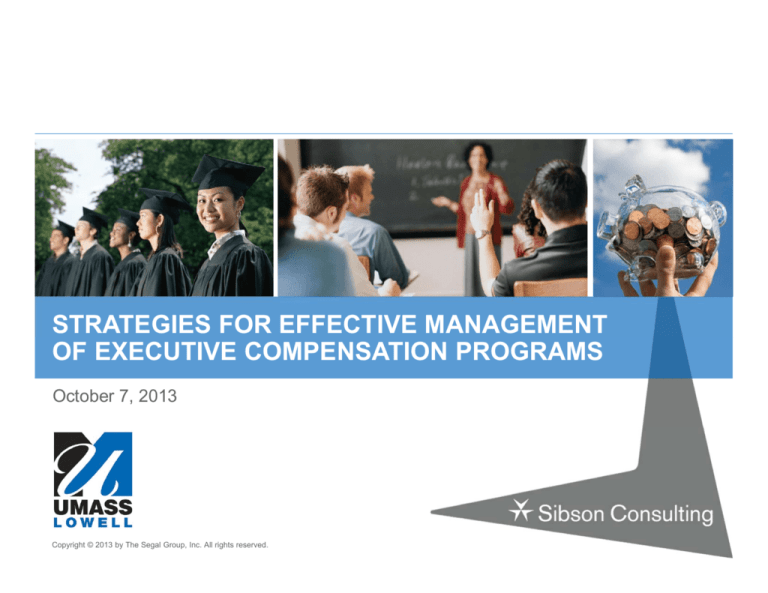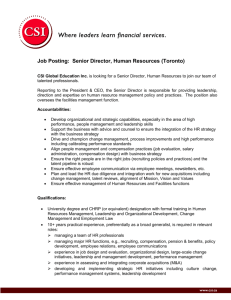
STRATEGIES FOR EFFECTIVE MANAGEMENT
OF EXECUTIVE COMPENSATION PROGRAMS
October 7, 2013
Copyright © 2013 by The Segal Group, Inc. All rights reserved.
Today’s Agenda
Executive Compensation Climate
Evaluating the Competitive Landscape
Q&A
Copyright © 2013 by The Segal Group, Inc. All rights reserved.
1
INTRODUCTION
Who’s Here Today?
Where are you from?
What functional area
do you represent?
Public institution
Private institution
For-profit institution
Finance
HR
Other
What is your role?
CFO
Controller
Budget Officer
HR Director
Other
What do you hope to get out of this session?
Learning about the regulatory environment
Information about retention
Deeper understanding of competitive assessment
Overall review of executive compensation and insight into best practices
Regardless of who you are and what brought
you here, we’re very glad that you’ve joined us.
2
INTRODUCTION
Who are We?
Lauren Turner
Associate Vice Chancellor for Human Resources
and Equal Opportunity and Outreach
University of Massachusetts, Lowell
Ms. Turner has served in leadership positions in higher education
human resources for over 30 years and has extensive experience in
total compensation, labor and employee relations, and workforce
management and development.
Elyse Rinaldi, CCP, GRP, CSCP
Consultant
Sibson Consulting
Ms. Rinaldi’s experience includes broad-based compensation
competitive assessment, sales compensation plan design and
analysis, custom survey writing and assessment, salary
structure design, and sales compensation plan implementation
assistance.
Ms. Rinaldi’s has served clients in a number of industries
including higher education, professional service, retail,
hospital/healthcare, and not-for-profit.
3
Current Executive Compensation
Trends in Higher Education
1
CLIMATE
Greater Rigor in Governance: Institutions are
becoming more complex and business-focused.
Emerging trends:
Compensation / Executive Committee
Increased documentation of process, timing, and decisions at the
Board level
Defined compensation decision-makers based on level
Competitive assessment analytics and other tools that guide
decisions about pay
4
Current Executive Compensation
Trends in Higher Education
2
CLIMATE
Prevalence of Incentives. Generally awarded
to key individuals based on performance
against specific goals
Transition to a more traditional business-oriented
management model
Financial constraints and the need for greater efficiency
More executive talent coming from outside of higher
education
Desire to differentiate compensation based on performance
5
Current Executive Compensation
Trends in Higher Education
CLIMATE
Additional Trends We Observe
Improved Optics and Transparency of Pay
Retention of Executives Using Deferred Compensation
Arrangements
Post-Termination Arrangements
Retirement & Succession Planning
6
What Could an Excess Benefit
Transaction Cost? A Lot!
CLIMATE
For the Disqualified Person
Initial excise tax of 25% on the amount of the excess benefit is
assessed
Disqualified person must “correct” the transaction (pay back the
institution)
If not timely, an additional excise tax of 200% of the excess benefit
is imposed
For Organization Managers
Excise tax of 10% of the amount of the excess
benefit, up to $10,000 per transaction
Generally applies to: officers, directors, or
Directors/Trustees who knowingly, willfully,
and without reasonable cause participate
in an excess benefit transaction
7
Higher Education Executive
Compensation is a Hot Topic
CLIMATE
Executive pay in higher education has become a popular
topic for public discourse:
A Google search for Executive Compensation in Higher Education
pulled up over 6 million entries
The Chronicle of Higher Education published over 120 articles on
executive compensation in the last 3 years, nearly half of which were
published in the past year
Hot button perks include:
First class or private flights
President’s houses
Country club memberships
Large golden
parachutes for exiting
and sometimes
disgraced officials
High pay at public universities
8
CLIMATE
Primer on Rebuttable Presumption
While rebuttable presumption is not required, if an IRS audit is initiated, the burden of proof is
shifted from the organization.
What does this mean?
For
Whom?
Disqualified
persons from
501(c)(3) and (4)
exempt
organizations
Comparable
Compensation
Study
What
Needed?
• People with substantial influence over institution affairs
(including family members)
• Voting members of the organization
• Named officers
• Current and former employees paid more than $150,000
Analysis of:
• Base
• Bonus
• Deferred compensation
• Nontaxable benefits
• Perquisites
• Compensation from
affiliated organizations
Note: These studies are often conducted by an outside firm.
Approval by
Independent Body
Board approval
Documentation of
Compensation
Decisions and
Rationale
Board minutes outlining nature of discussion and process
9
COMPETITIVENESS
What is Your Situation?
Do you have a
program for evaluating
competitiveness
in place today?
Yes
No
Are you happy with it?
Finance
HR
Other
If you answered no to either of the above
questions, why not? Let’s hear from you!
10
COMPETITIVENESS
Goals for Evaluating Compensation
Most institutions are trying to
accomplish some combination
of the following:
Which really means:
Attract Top Talent from Higher
Education and General Industry
Enticing people to leave jobs they
may love to come make your
institution stronger
Retain Top Talent Once They’ve
Joined the Institution
Treating people fairly so that they’ll
stick around
Use Resources More Efficiently
Avoiding public scrutiny of financial
decisions (and, in turn, potential
humiliation)
Comply with Government
Regulations
Staying out of jail
11
What Does it Mean to be
“Competitively Compensated”?
COMPETITIVENESS
There are many facets to competitiveness including:
Peers. Income is comparable to what could be earned at like
institutions
Positioning. Total target pay opportunity is +/- 15% of the
appropriate peer group median
Package. Pay and benefits match that of individuals with similar
responsibilities in the industry
Profit Sharing. Value creation is shared in reasonable proportion
between ownership and management
Personal Comfort. Compensation is not a driver of the employment
decision criteria
12
Best Practices in Executive
Compensation Benchmarking
1
Developing An Executive Compensation Philosophy
2
Peer Institution Focus
3
Total Compensation Perspective
4
Job Matching Sophistication
5
Inclusion of Talent Markets Outside of Higher Education
6
Internal Equity Reviews
7
Analysis Frequency
8
Use of a Third Party Advisor
13
Elements of an Executive Compensation Strategy
Best Practice #1: Institutions are creating more robust philosophy documentation,
which serves as the basis for comparison against external benchmarking results
Institutional
Alignment
How compensation supports and reinforces the strategic
objectives of the institution and its values
Elements of
Rewards
What rewards are used, the purpose for each, relative emphasis
and executive eligibility
Comparison
Markets
The criteria and rationale used for selecting comparator institutions
to benchmark compensation
The institutions selected, including any custom or unique views
Performance
Measurement
and Goal Setting
How to measure performance on an institutional and individual basis
The vehicles and processes to use to measure and communicate
performance and how they link to compensation outcomes
14
Elements of an Executive Compensation Strategy
continued
Compensation
Prominence
The relative prominence of pay in the rewards model
The role of pay in attracting and retaining talent versus other factors
Pay Positioning
The target pay positioning relative to the comparison markets (in
aggregate and for certain roles if they differ)
The factors influencing individual pay positioning and decision making
Program
Administration
Decision-making roles and accountabilities of the Board (as a
whole), Human Resources and Compensation Committee,
President, executive team, human resources and others
Communication /
Transparency
The degree of openness in sharing information on pay including:
Explanation of compensation strategy
Explanation of compensation program design
Expectations setting
Performance evaluation process and results
Consequences
15
Peer Institution Focus
Best Practice #2: Defining appropriate peer institutions is critical to
ensuring accurate, meaningful external comparisons
Common Factors include:
Institutional size
Ranking
Complexity
Public or private
Peer group definition is the area where results and conclusions are
affected so it is critical to choose wisely.
Sibson will be releasing studies in the coming months
regarding which factors impact pay. One interesting
preliminary finding: A substantial difference on just one
variable can produce about a 20 percent difference on pay.
16
COMPETITIVENESS
Sibson’s Employment Value Proposition
Best Practice #3
Appropriate benchmarking
includes all aspects of
compensation
Affiliation
Organization
commitment
Work environment
Citizenship
Title
Compensation
Base salary
Incentives
Cash recognition
Premium pay
Pay process
Work Content
Variety
Challenge
Autonomy
Meaningfulness
Feedback
EVP
Benefits
Health
Retirement
Recognition
Perquisites
Keep in mind
that there are
other factors
the attract and
retain key talent
Career
Advancement
Personal growth
Training
Employment
security
17
Details on Additional Trends
Best
Practice #4
Job Matching
Sophistication
Best
Practice #5
Inclusion of Talent
Markets Outside of
Higher Education
Best
Practice #6
Internal Equity
Reviews
Best
Practice #7
Analysis
Frequency
Best
Practice #8
Use of a Third
Party Advisor
• Roles and responsibilities vary across institutions
• Variances can create meaningful differences in nature
of roles
• Must be taken into account via benchmark studies
• Talent is being sourced from the general industry
(corporate and public sector)
• As such, these market should be taken into account
when benchmarking pay
• Internal comparisons of pay should also be conducted
• Ensures appropriate internal pay relationships across
the institution
• Reviews conducted every 12 – 24 months
• Third party advisors provide independent perspective
and compensation expertise
• They typically report to the Compensation Committee
18
COMPETITIVENESS
Key Messages Around Competitive Compensation
Compensation is an
art, not a science.
“Competitive"
doesn't imply
“given”
We seek to pay
competitively overall.
We don’t seek to pay
everyone the same.
Just because we got raises
or bonuses last year, it does
not mean we will in the future
unless we earn it.
The most critical factor
affecting base salary is
performance.
We do the best we can to
pay competitively based
on individual and
institutional performance
19
Thank you for joining us today!
20
Speaker Contact Information
Elyse Rinaldi, CCP, GRP, CSCP
erinaldi@sibson.com
Tel 212.251.5956
www.sibson.com
Lauren A. Turner
Associate Vice Chancellor for Human
Resources and Equal Opportunity & Outreach
Phone: 978-934-1804
Lauren_Turner@uml.edu
21






